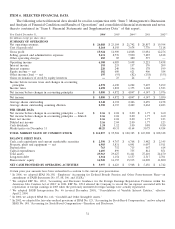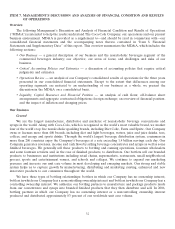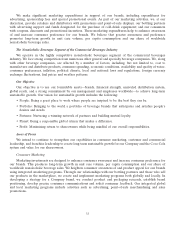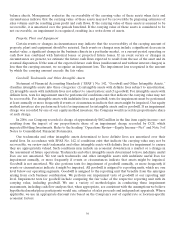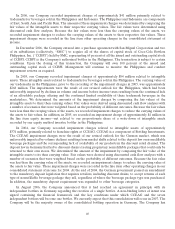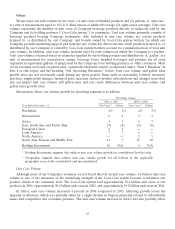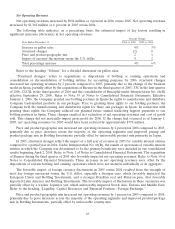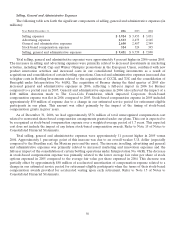Coca Cola 2006 Annual Report Download - page 43
Download and view the complete annual report
Please find page 43 of the 2006 Coca Cola annual report below. You can navigate through the pages in the report by either clicking on the pages listed below, or by using the keyword search tool below to find specific information within the annual report.considered and will continue to consider the effect of these future structural changes on the recoverability of
noncurrent assets and investments in bottling operations in Germany.
Revenue Recognition
We recognize revenue when persuasive evidence of an arrangement exists, delivery of products has
occurred, the sales price is fixed or determinable, and collectibility is reasonably assured. For our Company, this
generally means that we recognize revenue when title to our products is transferred to our bottling partners,
resellers or other customers. In particular, title usually transfers upon shipment to or receipt at our customers’
locations, as determined by the specific sales terms of each transaction.
In addition, our customers can earn certain incentives, which are included in deductions from revenue, a
component of net operating revenues in the consolidated statements of income. These incentives include, but
are not limited to, cash discounts, funds for promotional and marketing activities, volume-based incentive
programs and support for infrastructure programs. Refer to Note 1 of Notes to Consolidated Financial
Statements. The aggregate deductions from revenue recorded by the Company in relation to these programs,
including amortization expense on infrastructure programs, was approximately $3.8 billion, $3.7 billion and
$3.6 billion for the years ended December 31, 2006, 2005 and 2004, respectively.
Income Taxes
In July 2006, the FASB issued FASB Interpretation No. 48, ‘‘Accounting for Uncertainty in Income Taxes’’
(‘‘Interpretation No. 48’’). Interpretation No. 48 clarifies the accounting for uncertainty in income taxes
recognized in an enterprise’s financial statements in accordance with FASB Statement No. 109, ‘‘Accounting for
Income Taxes.’’ Interpretation No. 48 prescribes a recognition threshold and measurement attribute for the
financial statement recognition and measurement of a tax position taken or expected to be taken in a tax return.
Interpretation No. 48 also provides guidance on derecognition, classification, interest and penalties, accounting
in interim periods, disclosure and transition. For our Company, Interpretation No. 48 was effective beginning
January 1, 2007, and the cumulative effect adjustment will be recorded in the first quarter of 2007. We believe
that the adoption of Interpretation No. 48 will not have a material impact on our consolidated financial
statements.
Our annual tax rate is based on our income, statutory tax rates and tax planning opportunities available to
us in the various jurisdictions in which we operate. Significant judgment is required in determining our annual
tax expense and in evaluating our tax positions. We establish reserves at the time we determine it is probable we
will be liable to pay additional taxes related to certain matters. We adjust these reserves, including any impact on
the related interest and penalties, in light of changing facts and circumstances, such as the progress of a tax
audit.
A number of years may elapse before a particular matter for which we have established a reserve is audited
and finally resolved. The number of years with open tax audits varies depending on the tax jurisdiction. While it
is often difficult to predict the final outcome or the timing of resolution of any particular tax matter, we record a
reserve when we determine the likelihood of loss is probable. Such liabilities are recorded in the line item
accrued income taxes in the Company’s consolidated balance sheets. Settlement of any particular issue would
usually require the use of cash. Favorable resolutions of tax matters for which we have previously established
reserves are recognized as a reduction to our income tax expense when the amounts involved become known.
Tax law requires items to be included in the tax return at different times than when these items are reflected
in the consolidated financial statements. As a result, the annual tax rate reflected in our consolidated financial
statements is different than that reported in our tax return (our cash tax rate). Some of these differences are
permanent, such as expenses that are not deductible in our tax return, and some differences reverse over time,
such as depreciation expense. These timing differences create deferred tax assets and liabilities. Deferred tax
assets and liabilities are determined based on temporary differences between the financial reporting and tax
41


